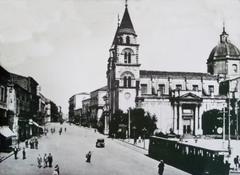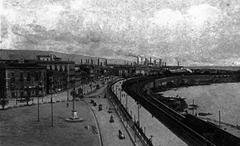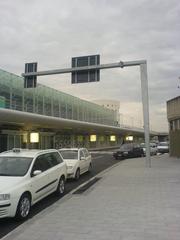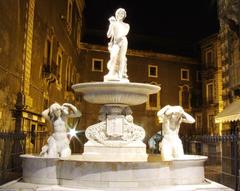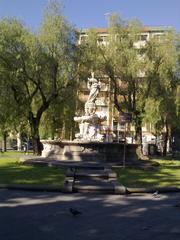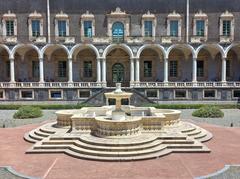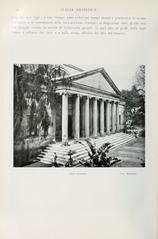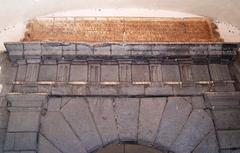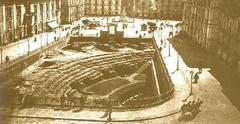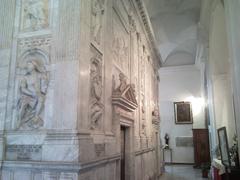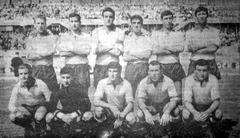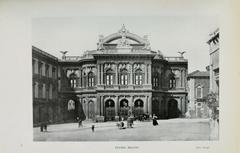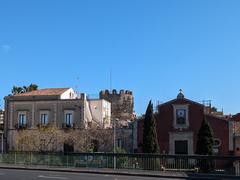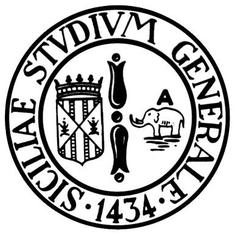Church of San Gaetano alle Grotte: Visiting Hours, Tickets, and Historical Significance in Catania, Italy
Date: 04/07/2025
Introduction
Located in the heart of Catania, Sicily, the Church of San Gaetano alle Grotte is a remarkable monument of faith, resilience, and architectural evolution. Tracing its origins to the early Christian era, this church uniquely incorporates a subterranean lava cave—once a clandestine place of worship and believed to be a burial site of St. Agatha, the city’s revered patron saint—beneath its elegant Baroque structure. The site stands as a testament to the enduring spiritual and cultural vitality of Catania, blending ancient volcanic geology with centuries of religious devotion and historical transformation (Comune di Catania; Showcaves.com; UNESCO World Heritage).
This guide explores the layered history of San Gaetano alle Grotte, its architectural highlights, spiritual significance, and offers essential visitor information—covering opening hours, ticketing, accessibility, travel tips, and practical considerations to enrich your experience.
Table of Contents
- Introduction
- Historical Overview: From Early Christianity to Baroque Splendor
- The Crypt and Early Christian Origins
- Medieval, Byzantine, and Norman Influences
- Baroque Reconstruction and Theatine Legacy
- Architectural and Artistic Highlights
- Religious and Cultural Importance
- Visiting Hours, Tickets, and Accessibility
- Travel Tips and Photographic Spots
- Frequently Asked Questions (FAQ)
- Nearby Attractions
- Visitor Experience and Practical Information
- Summary and Next Steps
- References
Historical Overview: From Early Christianity to Baroque Splendor
The Crypt and Early Christian Origins
San Gaetano alle Grotte is one of Catania’s oldest Christian sites. The church’s foundation is a natural lava cave, utilized as a Roman cistern before being converted into a place of worship as early as the 3rd century CE. This underground sanctuary bears witness to the clandestine practices of Catania’s early Christians during Roman persecution. Tradition holds that it was the first burial place of St. Agatha, whose cult remains central to the city’s spiritual identity (Comune di Catania; Catania Today).
The crypt features rough-hewn lava stone walls, original arcosolia (arched burial niches), and a baptismal font repurposed from the cistern. Its intimate, solemn atmosphere provides a direct link to the experiences of early Christian worshippers (Showcaves.com).
Medieval, Byzantine, and Norman Influences
Following the legalization of Christianity, the site was expanded and embellished during the Byzantine era. The crypt was adapted into a proper sanctuary, with characteristic altar pieces and triumphal arches. In the Norman period (11th–12th centuries), further modifications included the addition of staircases and the construction of the first above-ground church, incorporating Romanesque architectural features such as semicircular arches and sturdy masonry (Sicilia in Rete).
Baroque Reconstruction and Theatine Legacy
The catastrophic earthquake of 1693 destroyed much of Catania, including the original church. Rebuilding in the early 18th century coincided with the flourishing of Sicilian Baroque architecture. The new church, completed in the early 1700s and later dedicated to Saint Cajetan (San Gaetano), founder of the Theatine Order, reflects Baroque and Neoclassical stylistic influences. The Theatines oversaw the site, leaving a legacy visible in the church’s artistic and liturgical features (UNESCO World Heritage; CityMapSicilia.it).
Architectural and Artistic Highlights
- Lava Cave Crypt: The defining feature is the ancient lava cave, accessible by a staircase. The crypt’s arched burial niches, baptismal well, and stone columns provide a rare glimpse into early Christian, Byzantine, and Norman religious architecture (Showcaves.com).
- Baroque Upper Church: The above-ground church showcases a restrained Baroque façade, with elegant pilasters, a central portal, and a modest bell gable. Inside, a single nave with side chapels and a raised presbytery is supported by Norman columns. Baroque stuccoes and polychrome marble altars reflect 18th- and 19th-century Sicilian artistry (Evendo.com).
- Artworks and Relics: Highlights include a 17th-century statue of Saint Cajetan, several paintings, and relics associated with the Theatine Order.
- Defensive Elements: In the 16th century, fortifications were added due to the church’s strategic location—a reminder of its civic as well as sacred functions (Wikipedia IT).
Religious and Cultural Importance
San Gaetano alle Grotte holds dual significance: it is both a shrine to St. Agatha—especially during the annual Festa di Sant’Agata, when pilgrims visit the crypt—and a center of devotion to Saint Cajetan. The church remains active in Catania’s religious calendar, hosting Masses, commemorations, and special events. The crypt’s limited opening during Holy Week transforms it into a pilgrimage site, echoing its ancient role (Festa di Sant’Agata Official).
Visiting Hours, Tickets, and Accessibility
- Opening Hours: The upper church is open Tuesday to Sunday, typically from 9:00 AM to 1:00 PM and 3:00 PM to 6:00 PM. The crypt is only open to visitors during Holy Week (Thursday and Friday evenings until 9:00 PM). Hours may vary during religious festivals and public holidays (Comune di Catania).
- Tickets: Entry is free; donations are appreciated. Guided tours may require advance booking and a small fee.
- Accessibility: The upper church is accessible to most visitors, but the crypt involves a steep, narrow staircase and is not suitable for those with mobility challenges.
- Guided Tours: Available by arrangement through local tour agencies or by contacting the parish office (CityMapSicilia.it).
- Dress Code: Modest attire is requested; shoulders and knees should be covered.
Travel Tips and Photographic Spots
- Visit early in the day or late afternoon for a quieter experience and better lighting for photography.
- The lava stone crypt and Baroque interior offer excellent photographic opportunities—avoid flash to preserve artworks.
- Combine your visit with nearby attractions like Piazza Carlo Alberto’s market, the Roman amphitheater, and the Cathedral of Sant’Agata.
- Comfortable shoes are recommended for navigating stairs and uneven surfaces.
Frequently Asked Questions (FAQ)
Q: What are the visiting hours for San Gaetano alle Grotte?
A: Tuesday–Sunday, 9:00 AM–1:00 PM and 3:00 PM–6:00 PM; closed Mondays. The crypt is open only during Holy Week evenings.
Q: Is there an entrance fee?
A: No, entry is free; donations are appreciated.
Q: Is the church accessible for people with disabilities?
A: The upper church is accessible, but the crypt is not due to stairs.
Q: Can I attend Mass?
A: Yes, regular Masses and special events are held, especially on Saint Cajetan’s feast day (August 7th).
Q: Are guided tours available?
A: Yes, through local agencies or by contacting the church.
Nearby Attractions
San Gaetano alle Grotte is ideally situated for exploring Catania’s historical core. Nearby attractions include:
- Piazza Carlo Alberto: A lively market square offering local produce and Sicilian street food.
- Roman Amphitheater: One of the largest in Italy, just a short walk away.
- Cathedral of Sant’Agata: The city’s grandest church and a centerpiece of religious life.
- Basilica of the Madonna del Carmine: Another important Baroque church in the vicinity.
Visitor Experience and Practical Information
- Atmosphere: Visitors praise the tranquil, contemplative ambiance and the authenticity of the site, particularly the evocative lava cave crypt (Wanderlog).
- Facilities: Restrooms are limited on-site. No café or shop within the church, but many options are available nearby.
- Family & Groups: Children should be supervised in the crypt. The site is ideal for small groups or solo travelers seeking a personalized experience.
Summary and Next Steps
San Gaetano alle Grotte is a microcosm of Catania’s layered heritage, from its roots in early Christian martyrdom and Byzantine worship to Baroque revival and modern devotion. Its subterranean crypt and elegant upper church offer a unique spiritual and historical experience, while practical visiting conditions—free entry, regular hours, and proximity to other landmarks—make it accessible to all.
Before your visit, confirm current hours and special openings, especially if you wish to see the crypt or attend a guided tour. For further insights, download the Audiala app for audio guides and updates, and follow our social media for the latest news on Catania’s heritage sites.
References
- Comune di Catania
- Showcaves.com
- UNESCO World Heritage
- La Sicilia in Rete
- Wanderlog
- Catania Guide
- CityMapSicilia.it
- Festa di Sant’Agata Official
Ready to explore Sicily’s hidden treasures? Download the Audiala app for guided tours and up-to-date visitor information, and follow us for more insights into Catania’s remarkable history.
